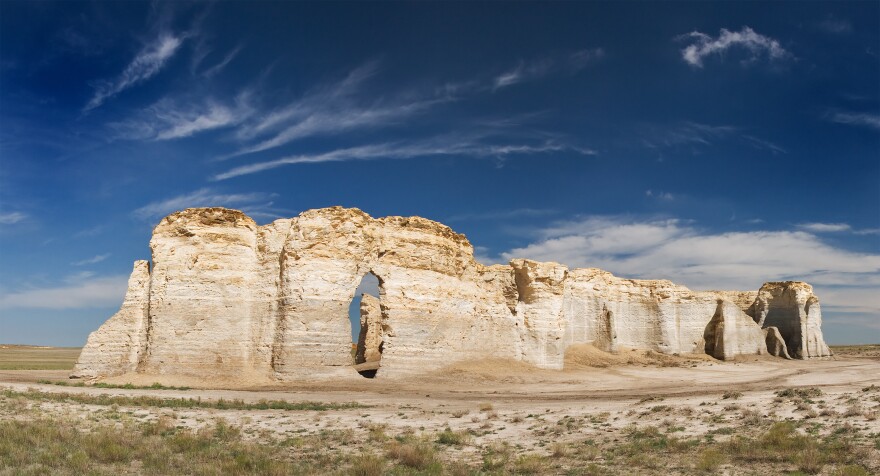This story was first published in KCUR's Creative Adventure newsletter. You can sign up to receive stories like this in your inbox every Tuesday.
To understand local lithology is to understand Kansas City’s origin story.
Locally and throughout the region, there’s plenty to fascinate rockhounds, history buffs, travelers, scientists and artists. Embedded in rock layers are fossils and other clues to the land and life cycles that existed before humans.
Our local rocks have been used to build edifices and roads, monuments and pathways, but all too often these impressive rocks perform as a backdrop, without full appreciation.
This week, we excavate some of the gems from Kansas City’s geological journey through time. Are you ready to rock?
Forming Kansas City

Some 300 million years ago, an inland sea ebbed and flowed, grew and receded, creating the interesting strata that appear in roadcuts and along hiking trails. Sedimentary limestone and shale, as well as loess (don’t fuss, it’s pronounced “luss”) form the bedrock of Kansas City, with some sandstone, conglomerate and coal, too.
While the glaciers of the last Ice Age (approximately 700,000 years ago) didn’t quite reach all the way down to Kansas City, Missouri, they pushed forward silt, shaping the land, and left erratic boulders of pink quartzite still found in the northern part of the area.
Because of a particular natural limestone ledge along the Missouri River, John McCoy was able to establish Westport Landing in 1834. He moved goods off the steamboats and into his trading post more efficiently than via the overland route from Independence, giving him an economic edge in the nascent boomtown.
Richard Gentile, professor emeritus from UMKC, explains this history (and some pre-history) in a recorded series of lectures on local geology from Linda Hall Library in early 2020.
Back then, the area was anything but flatland. Situated between the river and the bluffs, those early 19th-century soon-to-be Kansas Citians (the Town of Kansas wasn’t yet incorporated) started carving out roads from the loess as soon and as quickly as possible. Entire hills were dismantled in the quest for easier transportation and the need for building materials.
What were once massive limestone deposits became quarries, then residential areas and shopping centers, such as the area around Crestwood Shoppes at Oak and 55th Street.
That’s something to think about next time you stroll past one of the stone walls around Southmoreland Park or the Nelson-Atkins Museum of Art (though Andy Goldsworthy’s Walking Wall installation is sourced from Flint Hills stone of Kansas).
Thanks to those limestone deposits, another unique feature is North Kansas City’s Subtropolis complex. This cave network was carved by man and machine, mining the limestone into subterranean “rooms” which now house any number of businesses — including document storage for the National Archives, a climbing gym where you can go “bouldering” underground and the country’s most subterranean Post Office (150 feet below the surface).
There’s also underground space carved from the hills in Parkville, which hosts everything from academic offices to a distillery.
Get to know your rocks

Around these parts, most of the exposed rock we see is Bethany Falls Limestone, identified as a member of the Swope Formation, Kansas City Group, Pennsylvanian System. Named for Bethany, Missouri, this particular limestone is dotted around the city, a rock shelf about 15-30 feet thick that extends for hundreds of miles, shaping the landscape and ecology.
As important and ubiquitous as limestone is, the honor of being the state rock (or “lithologic emblem”) falls to Mozarkite, a pinkish sedimentary rock found in Benton County, about two hours southeast of the city.
You can learn more about the rocks, minerals and fossils of Missouri through the state Department of Natural Resources, where you can also purchase a ready-made collection of Missouri rocks or email “Ask a Geologist” with your rock questions.
The official state fossil, however, was found prominently in the Kansas City area. The crinoid (aka “starfish on a stick”) once proliferated in that primordial inland sea: In 1889, over 400 fossilized specimens were found at an excavation site at 10th and Grand.
Across the state line, Kansans claim two state fossils: the Tylosaurus (official Kansas state marine fossil) and Pteranodon (the official state flying fossil). The Kansas state rock is a different type of limestone, often used for post stones, which became a defining feature of the Kansas landscape.
The title became official in 2018 when the State Legislature also decreed galena the state mineral and jelinite amber the state gemstone (and some of the rarest amber in the world). An elementary student from Overland Park initiated the discussion and proposed the bill.
Learn more about the different types of rocks, minerals and geological curiosities with the Kansas Geological Survey.
Where to spot them

In many parts of the city, roadcuts reveal its lithologic character, but it’s a bit difficult to appreciate particular strata as you’re whipping around I-35, traveling on Truman Road or hurtling down Highway 210.
We find remnants of those original hills and ravines at 8th and Grand, along Main Street, supporting the Liberty Memorial, in Roanoke Park and even in the Westin Hotel at Crown Center, where the man-made waterfall in the lobby reveals a decent outcropping of limestone and shale strata.
At 87th and Blue Ridge Parkway, excavation exposed almost 1,000 feet of limestone and shale strata, described in Gentile’s “The Geology of Kansas City, Missouri,” an auto tour through the city. Cliff Drive, the shortest scenic byway in the country, has demonstrated the unique make-up of the region’s limestone bluffs since it was dedicated in 1905 (though currently only available to bikers and pedestrians).
There are a surprising number of hiking spots hidden in the rolling hills of Kansas City. The Swope Park Trails provide an up-close look at Bethany Falls Limestone outcroppings for bikers and hikers, with the Rocky Point Limestone Glade Trail accessible to hikers only, preserving the unique “glade” ecosystem that the limestone bedrock supports.
Lakeside Nature Center hosts the invigorating, though not overly taxing, Fox Hollow Trail. The two-mile loop has “early out” shortcuts, though if you start at the (not very well marked) west trailhead, you’ll be amidst the boulders in minutes.
Bethany Falls Trail in Burr Oak Woods Conservation Area is another friendly, yet impressive hiking trail just over 1 mile long. Enjoy a preview of the trail with this virtual tour.
Rock 'n' road trips

But once you’ve seen a few dozen outcroppings of Bethany Falls Limestone, do you feel like you’ve seen it all? Go farther afield to explore some gems just a day trip away.
In southeast Missouri, Elephant Rocks State Park features gigantic granite boulders, fascinating for geologists and just plain fun to climb on for kids. Similarly, there’s Rock City near Minneapolis, Kansas, a few football fields worth of climbable sandstone concretions, run by a nonprofit organization and maintained with a small fee from visitors.
Journey to the highest point of Missouri with a trip to Taum Sauk Mountain State Park, in the St. Francois Mountains, formed from igneous rock.
Thirty miles northwest of St. Joseph, the Loess Bluffs National Wildlife Refuge is both home to the region’s rich loess (windblown glacial soil) and a place for hundreds of thousands of migratory birds to rest. A loop trail climbs hundreds of feet to the top of the bluff for a breathtaking view of the refuge.
The farther from Kansas City you travel, the more landscape changes. Missouri is known as the “Cave State,” with more than 7,500 caves, many in the southern part of the state. In western Kansas, the supposedly all-flat landscape is dotted with magnificent towers of chalk at Little Jerusalem Badlands State Park, Castle Rock, and Monument Rocks.
In Arkansas, you can visit the Crater of Diamonds State Park, which allows visitors to dig for diamonds themselves. Just a wee bit beyond Missouri’s northeast border, Keokuk, Iowa, is home to geodes, Geode Fest and a selection of sites for geode hunting.
Where to learn more

There are many starting places to mine the depth of variety within the field of geology, where each type of rock or fossil reveals something unique in earth science.
At the University of Missouri-Kansas City's Volker campus, the Richard L. Sutton, Jr. Geosciences Museum, housed in the Miller Nichols Library, contains thousands of specimens of minerals, gems, petrified wood and fossils, featuring cephalopods and fluid inclusions (i.e., rocks with liquid trapped inside).
Missouri Geological Survey, part of the Missouri Department of Natural Resources, provides plenty of entry points in the state’s lithologic history, present and future. It provides access to numerous digital publications dating back decades, some even to 1853. The collection also includes the extensive 1980 report “Geological Wonders and Curiosities of Missouri.”
Also maintained with the Missouri Geological Survey is the Ed Clark Museum of Missouri Geology, in Rolla, Missouri, where the collection includes a mammoth tusk, meteorite and fluorescent minerals.
The Kansas Geological Survey is housed at the University of Kansas in Lawrence. Learn how underlying rock masses shift and shape the landscape throughout the state, creating distinct ecosystems. You can also visit the KU Biodiversity and Natural History Museum, with an array of Kansas-found fossils.
Linda Hall Library created a resource list to aid researchers and often hosts lectures related to earth science and the environment.
Another way to get first-hand exposure is by joining a local rockhounding club, for organized field trips and lecture series, rock swaps and more.
Want more adventures like this? Sign up for KCUR's Creative Adventure Email.







